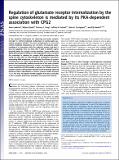Regulation of glutamate receptor internalization by the spine cytoskeleton is mediated by its PKA-dependent association with CPG2
Author(s)
Loebrich, Sven; Djukic, Biljana; Tong, Zachary J.; Cottrell, Jeffrey R.; Turrigiano, Gina G.; Nedivi, Elly; ... Show more Show less
DownloadLoebrich-2013-Regulation of glutam.pdf (1.769Mb)
PUBLISHER_POLICY
Publisher Policy
Article is made available in accordance with the publisher's policy and may be subject to US copyright law. Please refer to the publisher's site for terms of use.
Terms of use
Metadata
Show full item recordAbstract
A key neuronal mechanism for adjusting excitatory synaptic strength is clathrin-mediated endocytosis of postsynaptic glutamate receptors (GluRs). The actin cytoskeleton is critical for clathrin-mediated endocytosis, yet we lack a mechanistic understanding of its interaction with the endocytic process and how it may be regulated. Here we show that F-actin in dendritic spines physically binds the synaptic nuclear envelope 1 gene product candidate plasticity gene 2 (CPG2) in a PKA-dependent manner, and that this association is required for synaptic GluR internalization. Mutating two PKA sites on CPG2 disrupts its cytoskeletal association, attenuating GluR endocytosis and affecting the efficacy of synaptic transmission in vivo. These results identify CPG2 as an F-actin binding partner that functionally mediates interaction of the spine cytoskeleton with postsynaptic endocytosis. Further, the regulation of CPG2/F-actin association by PKA provides a gateway for cellular control of synaptic receptor internalization through second messenger signaling pathways. Recent identification of human synaptic nuclear envelope 1 as a risk locus for bipolar disorder suggests that CPG2 could play a role in synaptic dysfunction underlying neuropsychiatric disease.
Date issued
2013-11Department
Massachusetts Institute of Technology. Department of Biology; Massachusetts Institute of Technology. Department of Brain and Cognitive Sciences; Picower Institute for Learning and MemoryJournal
Proceedings of the National Academy of Sciences
Publisher
National Academy of Sciences (U.S.)
Citation
Loebrich, S., B. Djukic, Z. J. Tong, J. R. Cottrell, G. G. Turrigiano, and E. Nedivi. “Regulation of Glutamate Receptor Internalization by the Spine Cytoskeleton Is Mediated by Its PKA-Dependent Association with CPG2.” Proceedings of the National Academy of Sciences 110, no. 47 (November 4, 2013): E4548–E4556.
Version: Final published version
ISSN
0027-8424
1091-6490